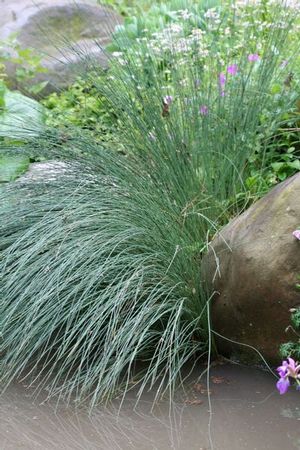New Moon Nurseries
Carex stricta
Tussock sedge
Native to North America
FIRST IMPRESSIONS: Carex stricta is a tufted wetland sedge that forms colonies from underground rhizomes. New leaves are bright green and fountain-like. In spring culms rise above the foliage bearing dense erect flower stalks. The green inflorescences mature into spikey chocolate brown seed clusters. This sedge is a tussock forming aquatic emergent. It prospers in sun or part sun and in standing water or wet mucky soil.
HABITAT & HARDINESS: Carex stricta is native to parts of eastern and central North America from Manitoba to Nova Scotia, south from Maine to Georgia and west from North Dakota to Texas.
This sedge is indigenous to sedge meadows, seeps, fens, seasonal sandy or non-sandy wetlands, wet prairies, marsh edges, wet meadows and savannas with alluvial soil. In its native habitat, Carex stricta is often the dominant plant.
Hardy from USDA Zones 5-8.
PLANT DESCRIPTION: Carex stricta is a vigorous sedge that forms numerous leafy culms from underground rhizomes. Plants form tussocks or mounded clumps that sit slightly above the water level.
Old leaves are usually retained for a year or more. They develop a straw color and remain below the new bright green leaves.
In spring fertile culms rise above the foliage displaying a 1’ green cat-tail shaped inflorescence. The inflorescence contains 1-3 staminate spikelets, 2-4 pistillate spikelets and many leafy bracts. Pistillate spikelets mature into deep brown seed clusters.
Plants are about 3-4’ tall with an equal spread. They grow taller in wet sites and often forms dense colonies that offer cover for wetland birds.
CULTURAL & MAINTENANCE NEEDS: Carex stricta thrives in full sun or partly shaded sites with moist, mucky or wet soil.
This sedge prospers in shallow standing water and tolerates short periods of drought, heavy clay soil and seasonal flooding. Plants can be cultivated away from a natural body of water, if supplemental moisture is provided.
In natural settings, retain the straw colored old leaves because they filter and clarify water. In gardens, for aesthetic reasons the foliage can be cut to the ground in early spring before new growth is initiated.
Plants are pest resistant and unpalatable to deer and other herbivores.
LANDSCAPE USES: Carex stricta is valuable for Wetland Restoration and Erosion Control in Bioswales and drainage ditches. This sedge can be used to reduce maintenance and hold ground on various shorelines. Plants are useful in Deer Resistant Plantings, Wet Meadows, Stormwater Projects and Wildlife Gardens.
COMPANION & UNDERSTUDY PLANTS: Try pairing plants with Asclepias incarnata, Aster puniceus, Iris versicolor, Iris virginica, Juncus effusus and Scirpus cyperinus.
Carex vulpinoidea is similar in appearance and cultural needs and can be substituted if needed.
TRIVIA: Carex stricta hosts caterpillars of Appalachian Brown and Eyed Brown Butterflies along with several species of Skippers and moths. Wetland birds and turtles feed on the seed. Dense colonies provide excellent cover for birds and other wildlife. The Sedge Wren feeds and nests in sites dominated by wetland sedges.
In a sedge meadow, the old leaves of Carex stricta and other sedges die and collapse into the muck. They decompose into something similar to peat. During dry seasons, the peat-like substrate and dried leaves fuel the burns that are necessary to deter woody plants.
Height:
3-4 ftSpread:
1-2 ftUSDA Hardiness Zone:
5-8Bloom Color:
Green, TanCarex stricta Characteristics
Attributes
- Bog
- Naturalizing
- Evergreen
- Dried Flower
- Cut Flower
Exposure
- Partial Shade to Full Sun
Deer Resistant
- Deer Resistant
Flowering Months
- June
Soil Moisture Preference
- Wet to Moist
Interesting Notes:
For more information on this plant, visit the USDA PLANTS Database: http://plants.usda.gov/java/profile?symbol=CAST8
